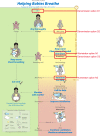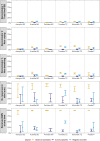Neonatal resuscitation: EN-BIRTH multi-country validation study
- PMID: 33765958
- PMCID: PMC7995695
- DOI: 10.1186/s12884-020-03422-9
Neonatal resuscitation: EN-BIRTH multi-country validation study
Abstract
Background: Annually, 14 million newborns require stimulation to initiate breathing at birth and 6 million require bag-mask-ventilation (BMV). Many countries have invested in facility-based neonatal resuscitation equipment and training. However, there is no consistent tracking for neonatal resuscitation coverage.
Methods: The EN-BIRTH study, in five hospitals in Bangladesh, Nepal, and Tanzania (2017-2018), collected time-stamped data for care around birth, including neonatal resuscitation. Researchers surveyed women and extracted data from routine labour ward registers. To assess accuracy, we compared gold standard observed coverage to survey-reported and register-recorded coverage, using absolute difference, validity ratios, and individual-level validation metrics (sensitivity, specificity, percent agreement). We analysed two resuscitation numerators (stimulation, BMV) and three denominators (live births and fresh stillbirths, non-crying, non-breathing). We also examined timeliness of BMV. Qualitative data were collected from health workers and data collectors regarding barriers and enablers to routine recording of resuscitation.
Results: Among 22,752 observed births, 5330 (23.4%) babies did not cry and 3860 (17.0%) did not breathe in the first minute after birth. 16.2% (n = 3688) of babies were stimulated and 4.4% (n = 998) received BMV. Survey-report underestimated coverage of stimulation and BMV. Four of five labour ward registers captured resuscitation numerators. Stimulation had variable accuracy (sensitivity 7.5-40.8%, specificity 66.8-99.5%), BMV accuracy was higher (sensitivity 12.4-48.4%, specificity > 93%), with small absolute differences between observed and recorded BMV. Accuracy did not vary by denominator option. < 1% of BMV was initiated within 1 min of birth. Enablers to register recording included training and data use while barriers included register design, documentation burden, and time pressure.
Conclusions: Population-based surveys are unlikely to be useful for measuring resuscitation coverage given low validity of exit-survey report. Routine labour ward registers have potential to accurately capture BMV as the numerator. Measuring the true denominator for clinical need is complex; newborns may require BMV if breathing ineffectively or experiencing apnoea after initial drying/stimulation or subsequently at any time. Further denominator research is required to evaluate non-crying as a potential alternative in the context of respectful care. Measuring quality gaps, notably timely provision of resuscitation, is crucial for programme improvement and impact, but unlikely to be feasible in routine systems, requiring audits and special studies.
Keywords: Birth; Coverage; Health management information systems; Hospital records; Measurement; Neonatal resuscitation; Quality; Survey; Validity.
Conflict of interest statement
The authors declare that they have no competing interests.
Figures









References
-
- Lee AC, Cousens S, Wall SN, Niermeyer S, Darmstadt GL, Carlo WA, et al. Neonatal resuscitation and immediate newborn assessment and stimulation for the prevention of neonatal deaths: a systematic review, meta-analysis and Delphi estimation of mortality effect. BMC Public Health. 2011;11:S12. doi: 10.1186/1471-2458-11-S3-S12. - DOI - PMC - PubMed
-
- United Nations Inter-agency Group for Child Mortality Estimation (UN IGME). A Neglected Tragedy: The global burden of stillbirths. New York: United Nations Children’s Fund; 2020. https://data.unicef.org/resources/a-neglectedtragedy-stillbirth-estimate.... Accessed 12 Oct 2020.
Publication types
MeSH terms
Grants and funding
LinkOut - more resources
Full Text Sources
Other Literature Sources
Research Materials

